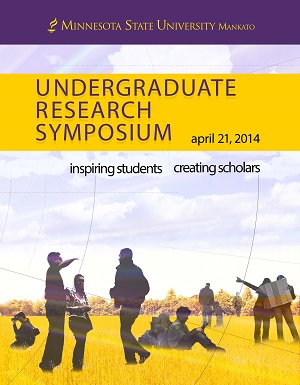Event Title
Environmental Effects of Garbage Island
Location
CSU Ballroom
Start Date
21-4-2014 10:00 AM
End Date
21-4-2014 11:30 AM
Student's Major
Biological Sciences
Student's College
Science, Engineering and Technology
Mentor's Name
Marilyn Hart
Mentor's Email Address
marilyn.hart@mnsu.edu
Mentor's Department
Biological Sciences
Mentor's College
Science, Engineering and Technology
Description
Vast amounts of garbage accumulate in the gyres of the Pacific Ocean and impact the environment, marine life and wildlife located on nearby islands. First discovered in 1972, the island patch is made up of microscopic particles of plastic, mostly polypropylene. Entanglement of fishing lines and ingestion of these particles cause injury or death of approximately 267 species worldwide that includes 86% of all sea turtles, 44% of all seabird species, 43% of all marine mammal species and numerous fish and crustacean species. Project Kaisei has conducted clean up attempts and surveys of the Pacific gyre. The clean up efforts have had little effect on large-scale garbage patches. Other solutions would be to stop using plastics or devise a new version of plastic that is less harmful to the environment. However, plastic has become a vital part of society, which consumers and manufacturers rely on. Of ethical concern is that despite worldwide use of plastic, no one claims ownership of the oceans and therefore responsibility. Who should clean up the mess and how? Who will take ownership and take steps to improving an ecosystem we rely upon for food and consumer goods? In this study, current strategies to clean up our oceans will be addressed.
Environmental Effects of Garbage Island
CSU Ballroom
Vast amounts of garbage accumulate in the gyres of the Pacific Ocean and impact the environment, marine life and wildlife located on nearby islands. First discovered in 1972, the island patch is made up of microscopic particles of plastic, mostly polypropylene. Entanglement of fishing lines and ingestion of these particles cause injury or death of approximately 267 species worldwide that includes 86% of all sea turtles, 44% of all seabird species, 43% of all marine mammal species and numerous fish and crustacean species. Project Kaisei has conducted clean up attempts and surveys of the Pacific gyre. The clean up efforts have had little effect on large-scale garbage patches. Other solutions would be to stop using plastics or devise a new version of plastic that is less harmful to the environment. However, plastic has become a vital part of society, which consumers and manufacturers rely on. Of ethical concern is that despite worldwide use of plastic, no one claims ownership of the oceans and therefore responsibility. Who should clean up the mess and how? Who will take ownership and take steps to improving an ecosystem we rely upon for food and consumer goods? In this study, current strategies to clean up our oceans will be addressed.
Recommended Citation
Gronewold, Katy. "Environmental Effects of Garbage Island." Undergraduate Research Symposium, Mankato, MN, April 21, 2014.
https://cornerstone.lib.mnsu.edu/urs/2014/poster_session_A/12



